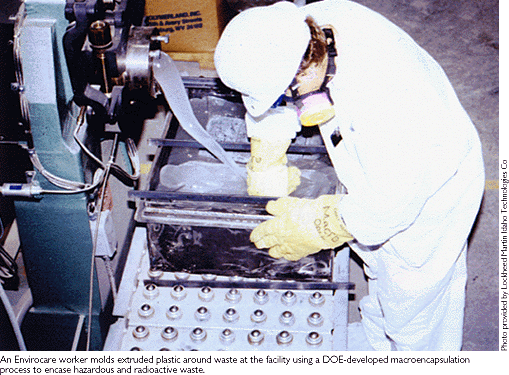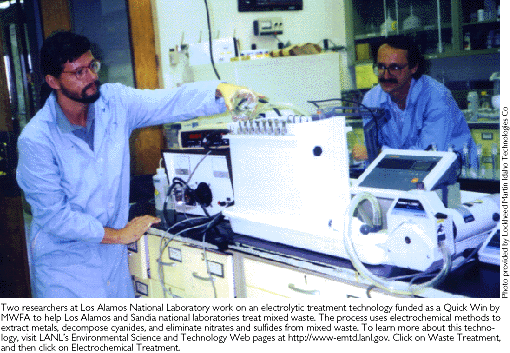
on the mixed waste focus area
About the focus areas
The
U.S. Department of Energy's Office of Environmental
Management has
established an integrated approach for addressing waste
issues based on problem, or focus areas. The focus areas
are subsurface contaminants; mixed waste
characterization, treatment, and disposal; radioactive
tank waste remediation; decontamination and
decommissioning; and plutonium stabilization. Three
crosscutting technology areas support the focus areas:
characterization, monitoring, and sensor technology;
efficient separations and processing; and robotics.
Mixed waste contains both hazardous
chemical components, subject to the requirements of the
Resource Conservation and Recovery Act, and radioactive
components, subject to the requirements of the Atomic
Energy Act. The U.S. Department of Energy's inventory of mixed waste consists of over
2,000 different mixed waste streams at 36 sites in 19
states. Faced with multibillion dollar estimates for
treating and disposing of mixed low-level and mixed
transuranic waste, DOE established the mixed waste focus
area in 1995 to pursue technology leading to better and
less expensive characterization, retrieval, handling,
treatment, and disposal of mixed waste. MWFA's goals are
to reduce the volume of stored mixed waste and meet
regulatory requirements for safe, permanent disposal.
Zeroing in on
deficiencies
Under the leadership of the Idaho Operations Office
and with the support of Lockheed Martin Idaho
Technologies Co. and the Waste
Policy Institute at the Idaho
National Engineering and Environmental Laboratory in
Idaho Falls, the focus area "zeroed in on the
processes or unit operations that were inadequate to
support treatment of mixed waste," according to MWFA
Deputy Manager Bill Owca. "We defined those things
that prevented implementation as deficiencies, and we
will focus on them until we have them all resolved."
When finished, the program will have demonstrated
improvements to 55 proposed mixed waste treatment systems
at 22 DOE sites. These technology enhancements not only
will make treating mixed waste better and safer, but are
expected to shave millions of taxpayer dollars off the
DOE "mortgage" to clean up its weapons complex
facilities.

Beginning with customer site visits and analysis of
needs from Site Technology Coordination Groups, as well
as data from site treatment plans and mixed waste
inventory reports, focus area staff used a systems
engineering approach to develop a prioritized list of
technology deficiencies, which constitutes the MWFA
technical baseline. Technical performance requirements
necessary to resolve each deficiency were then described.
The final step in resolving a deficiency is comparison of
the technology development and demonstration results
against requirements to ensure their fulfillment. The
integrated technical baseline currently has 24
deficiencies, the highest priorities being
characterization; mercury, ash, and salt stabilization;
waste form performance; material handling; mercury
separation; TRU waste transportation; and continuous
emission monitors.
To facilitate development of appropriate technologies,
MWFA uses product lines that reflect the major mixed
waste problem categories: wastewaters and slurries;
combustible organics; inorganic homogeneous solids and
soils; solids, debris, and soils; and unique wastes.
These waste-type product lines are managed by waste-type
managers, who are members of MWFA's customer
organizations--Office of Waste Management (EM-30), Office
of Environmental Restoration (EM-40), and Office of
Nuclear Material and Facility Stabilization (EM-60).
Waste-type teams for each product line provide technical
and regulatory support and tribal and stakeholder
interface to principal investigators.
Wrapping up
technology systems
At the same time they were overseeing resolution of
technology deficiencies, MWFA staff worked toward
completing by the end of fiscal year 1997 the development
of three technology systems it will endorse as being
cumulatively capable of treating at least 90 percent of
DOE's mixed waste inventory. Some of the candidates for
standard bearers are melter technologies,
macroencapsulation and other stabilization processes for
waste streams for which vitrification is problematic, and
alternative technologies for organic destruction.
High-temperature melter
technologies--MWFA's melter strategy is
aimed at development activities to support the Plasma
Hearth Process (see Initiatives,
February 1996) and the Direct Current Arc melter
because these technologies have the potential to treat a
wide variety of stored and buried mixed waste in a single
process. In support of melter development, MWFA has
involved Russian scientists, who have been researching
the behavior of radionuclides in high-temperature
processes. MWFA has also provided implementation support
to the Transportable Vitrification System at the Oak
Ridge National Laboratory (see Initiatives,
December 1996), supported the Vortec melter
demonstration at the Paducah Gaseous Diffusion Plant (see Initiatives, October 1996),
and supported the Western Environmental Technology
Office's work on enhancing the service life of plasma
torches. (Mississippi
State University's Diagnostic Instrumentation and
Analysis Laboratory is also involved in research to
extend the life of plasma torches. See page 4.)
For the continuous detection of hazardous emissions in
the off-gas of melter systems, MWFA participates in
seeking improvements to continuous emissions monitors.
MWFA joined a working group designed to coordinate CEM
technology development between government agencies and
private industry. The Interagency Continuous Emission
Monitors Coordinating Committee/Working Group seeks to
eliminate duplicative R&D efforts and speed up
schedules. MWFA expects to leverage CEM funding with
other agencies.
Polymer
macroencapsulation and other stabilization technologies--Polymer
macroencapsulation, developed at Brookhaven National
Laboratory, surrounds mixed low-level wastes with a layer
of clean polyethylene to isolate the contaminants from
the environment. The U.S.
Environmental Protection Agency has defined polymer
macroencapsulation as the Best Demonstrated Available
Technology for radioactive lead soils and mixed waste
debris, defined as materials exceeding 60 mm in particle
size.
MWFA was instrumental in the transfer of polymer
macroencapsulation to the private sector. Through an
August 1995 cooperative agreement between DOE and
Envirocare of Utah, Envirocare uses macroencapsulation to
treat wastes it receives from DOE sites. The transfer of
polymer macroencapsulation to Envirocare is one of MWFA's
major successes, and it serves as a model for other
transfers of DOE-developed technologies to the private
sector to solve DOE environmental problems (see Initiatives, February 1996).
MWFA has coordinated shipments of radioactive lead from
DOE sites to the low-level nuclear waste disposal
facility 75 miles west of Salt Lake City. Envirocare has
received shipments from 23 DOE sites. The focus area also
renegotiated the cooperative agreement to allow Los Alamos National Laboratory
in New Mexico to ship 60,000 pounds of radioactive lead,
the site's entire inventory.
As part of its investigation of alternatives for
problematic waste streams, MWFA is planning an "Ash
Bake-Off" scheduled for this fall or winter to
compare and contrast three different ash stabilization
technologies for treating fly ash. After passing through
an off-gas system of an incineration process, fly ash is
what remains. Ash stabilization is one of the focus
area's 24 technology deficiencies in treating mixed
waste. Phosphate-bonded ceramics, RocTec (a commercial
process), and sintered ceramic stabilization will be
tested at bench scale and later at drum scale, using ash
from the Waste Experimental Reduction Facility at the
Idaho National Engineering and Environmental Laboratory.
Performance strengths--such as leachability, compressive
strength, waste loading, volume reduction, operability,
and cost--will be gathered on each technology for
customers to evaluate. See article about chemically
bonded phosphate ceramics in this issue.
Alternative organic
destruction--MWFA is supporting three
technologies that are chemical alternatives to
high-temperature processes for combustible mixed
low-level waste: DETOXSM, acid
digestion, and direct chemical oxidation.
DETOX is a chemical wet oxidation method, developed
and patented by Delphi Research, Inc. of Albuquerque, New
Mexico (see Initiatives,
August 1996 and this issue).
DETOX destroys hazardous organics and concentrates heavy
metals and radionuclides in a process solution while
controlling releases of hazardous air pollutants.
Acid digestion is another wet oxidation technology.
Operating below 200oC and at
atmospheric pressure, the process treats heterogeneous
waste with a nitric-phosphoric acid. Treated residues are
immobilized readily using phosphate ceramic
solidification. A license agreement has been negotiated
between Westinghouse Savannah River Company and CeraChem,
a private company. Initial testing with surrogate waste
has begun in a 40-liter pilot unit, and plans are under
way to design, construct, and test a 400-liter reactor.
MWFA is supporting the bench-scale demonstration of
direct chemical oxidation as a unique omnivorous
destruction process for organic solids and liquids. Using
acidified ammonium peroxydisulfate solutions, the process
does not require any toxic or expensive catalysts for
bulk destruction. The process operates within the aqueous
phase at low temperature and ambient pressure, and the
reagent can be regenerated and recycled.

Quick wins
The Quick Win program is a strategy the focus area has
successfully used to quickly clean up small unique
quantities of mixed waste. Projects pegged as quick wins
are those for which mature technologies can be
demonstrated and deployed within a given fiscal year to
reduce DOE's inventory of noncompliant mixed waste. Once
treatability studies have proven successful, end users
can permit the process and begin treating mixed waste.
Quick wins generate data other sites can use to assess
applicability to similar wastes at their facilities. The
annual $2.4 million Quick Win program has helped 14 sites
reduce their mixed waste inventories. By the end of FY97,
a total of 653 cubic meters of mixed waste will have been
treated under the program.
Quick Win projects are solicited from DOE sites
through a call for proposals. For the FY97 program, 12
projects are being funded. One of the FY97 projects will
use an electrochemical process to regenerate ion exchange
resins at Oak Ridge National Laboratory, thereby reducing
the generation of secondary waste and saving almost
$700,000 a year in avoided costs. Another project at Argonne National
Laboratory-West will use phosphate-bonded ceramics to
stabilize two waste streams--lead-lined gloves and
crushed mercury-contaminated light bulbs. The
demonstration will be coordinated with other
stabilization demonstrations to provide comparisons of
stabilization technologies under identical testing
conditions.
Among the quick wins of 1996 was a project using a
full-scale, base hydrolysis nonthermal process to destroy
explosives at the Pantex Plant in Amarillo, Texas. The
technology was funded because customers were looking for
an alternative to open burning of dismantled materials.
The technology neutralized 500 pounds of contaminated
explosives and generated data that are being used to
obtain an operating permit for the technology.
Public involvement
MWFA's Regulatory and External Liaison Program
facilitates regulator, tribal, and stakeholder
involvement within the focus area to enhance the
implementation of mixed waste treatment systems. Through
its participation in the National Technical Workgroup and
the Interstate Technology and Regulatory Cooperation
Working Group (see Initiatives,
April 1997), MWFA gains the perspectives of
regulatory agencies, stakeholders, and tribes.
NTW--composed of representatives from DOE, EPA, the
Nuclear Regulatory Commission, regulating states, and
citizen groups--supports the development of coordinated,
consistent, and environmentally protective processes for
permitting mixed waste thermal treatments. ITRC promotes
cooperation among states in the common effort to test,
demonstrate, evaluate, verify, and deploy innovative
environmental technologies.
MWFA affords another opportunity for public
involvement through development of its Technology
Development Requirements Documents, which provide a guide
for investigators when designing their technology
development activities. TDRDs specify verifiable
requirements for each project to ensure that development
projects meet customer needs and can be implemented
successfully. Tribal and stakeholder participants on the
Technology Requirements Working Group develop and define
requirements that reflect tribal and stakeholder social,
political, and cultural values and economic concerns.
TRWG has reviewed and submitted recommendations to MWFA
on the following TDRDs: salt stabilization, polymer
encapsulation, radionuclide partitioning, heavy-metal
monitoring, dioxin/furan monitoring, controlled emissions
demonstration, and mercury amalgamation.
For more information, see MWFA's homepage at http://wastenot.inel.gov/mwfa.
|

